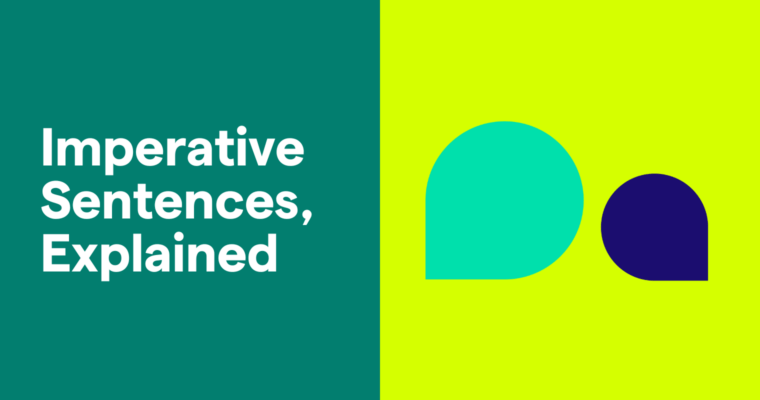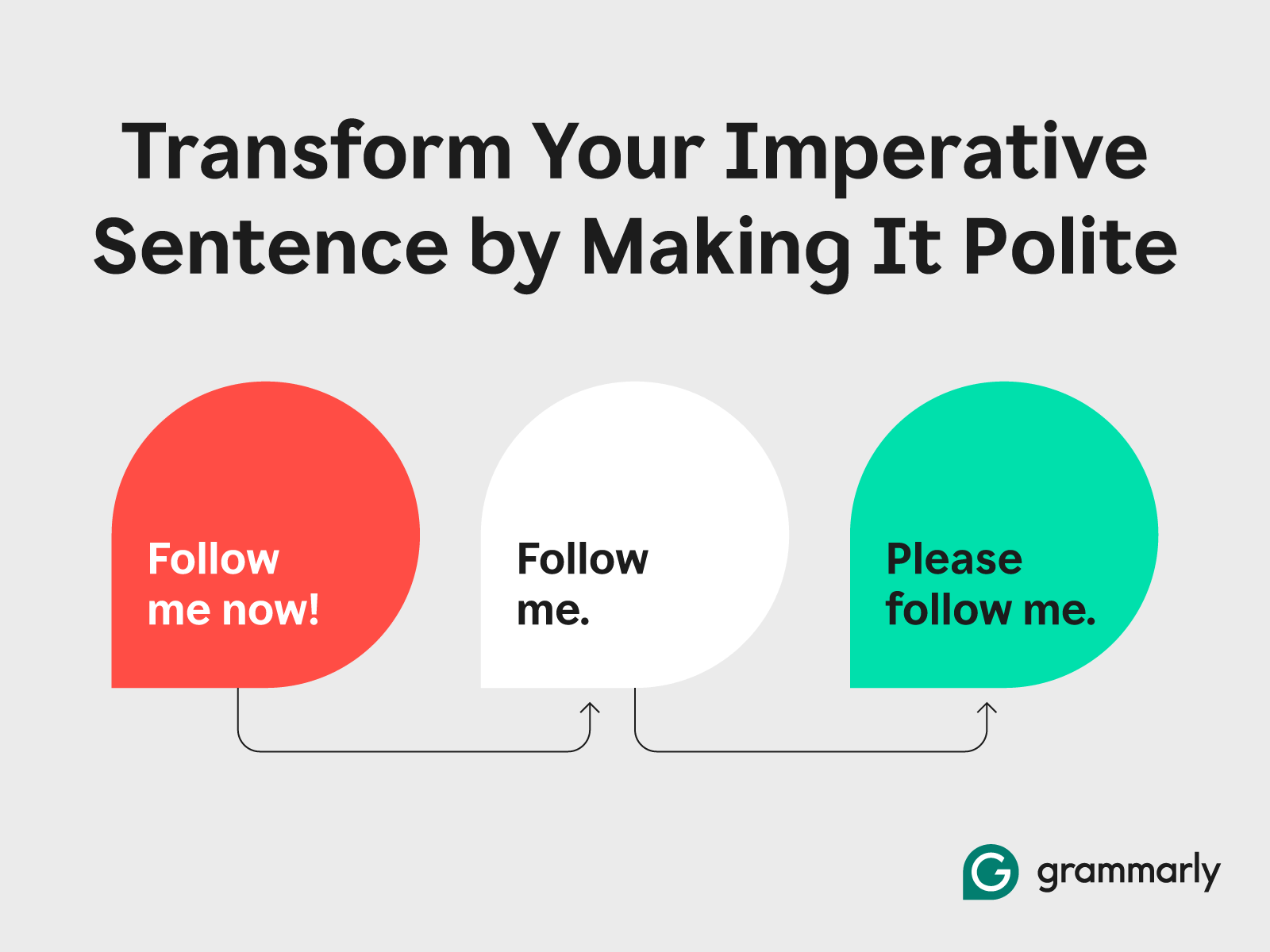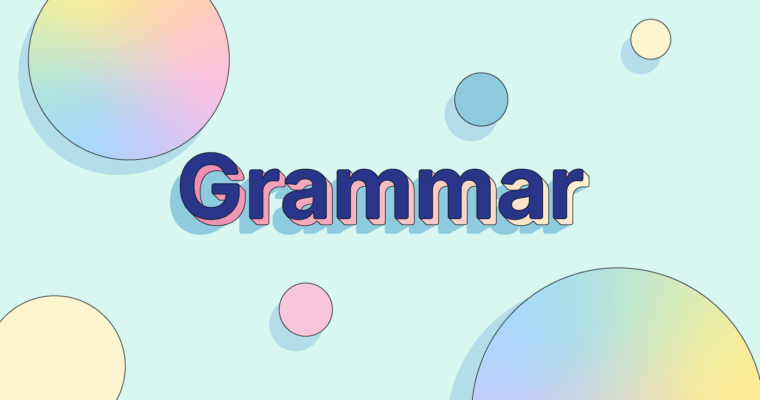
Key takeaways:
- Imperative sentences are a type of sentence that expresses a direct command, warning, instruction, or request.
- Imperative sentences do not always explicitly state a subject because the subject (“you”) is implied.
- “Stop!” is one of the most common examples of an imperative sentence.
Imperative sentences are how you communicate the things you need others around you to do. They are one of the most important types of sentences to know for creating a direct and authoritative tone. A common instance where we use imperative sentences is when we are issuing commands to dogs. For example, “Sit!,” “Stay!,” “Leave it!,” or “Come!” are all examples of imperative sentences.
Learn more about imperative sentences and how they’re structured and see examples of their use in our guide below.
Table of contents
What are imperative sentences?
Examples of imperative sentences
How to soften imperative sentences
What are imperative sentences?
An imperative sentence is a command, a warning, an instruction, or a request. These sentences typically begin with a verb, and the subject of the sentences doesn’t explicitly need to be stated by the speaker because it’s typically you.
However, the subject doesn’t necessarily have to be another person. For example, when you tell Alexa to “Start a timer for 10 minutes,” you’re using an imperative sentence.
Imperative is one of the five grammatical moods. The others are:
- Indicative mood, which expresses facts, opinions, and questions
- Subjunctive mood, which expresses wishes, doubts, possibilities, or suggestions
- Interrogative mood, which asks questions
- Conditional mood, which communicates actions dependent on certain conditions
An imperative statement, on the other hand, directs someone to do something and is conveyed using an imperative sentence. Imperative sentences usually imply that the given statement is unavoidable and important.
Imperative sentence structure
The imperative is one of the five main grammatical moods, so its verbs are structured within a sentence in a specific way. Imperative sentences often start with imperative verbs in the simple present tense to signal a command to an implied subject. Here are some examples with the imperative verb italicized:
- Follow me.
- Go back to school.
- Walk on the right side of the pathway.
While the imperative verb usually appears at the beginning of an imperative sentence, words like please or auxiliary verbs like do (in negative imperatives) and make sure can precede it to modify the tone or add emphasis. Here are some examples where the verb appears later in an imperative sentence:
- Make sure you understand why we do this exercise.
- Please don’t spoil the movie.
The subject of an imperative sentence is almost always the implied second-person pronoun, you, since the sentence directly addresses the listener or reader. For example, in the imperative sentence “Wait here,” the you is implied and refers to whomever the speaker is talking to.
But, in some imperative sentences, an indirect object—an object that receives the object of a sentence—also follows the verb. Take these examples: “Show me the money” or “Tell us your story.” In others, there is no indirect object. And in some imperative sentences, like those below, the verb is the entire sentence:
- Go.
- Stop!
- Run!
While every type of sentence differs, imperative sentences always end with a period or an exclamation point. When an imperative is phrased as a question, perhaps in order to soften its tone, it ends with a question mark.
Examples of imperative sentences
An imperative sentence can tell its subject to do (or not do) just about anything. Here are a few more examples of imperative sentences:
- Don’t answer the door unless your parents are home.
- Please open with care.
- Judge the submissions by their artistic merit, not their technical skill.
There are three types of imperative sentences you can include in your writing. Explore them in the table below:
| Type of imperative sentence | Definition | Examples |
| Affirmative imperative sentence | Tells the reader or listener to take a specific action |
Put your plate in the sink. Ask the teacher about last night’s homework. Call me! |
| Negative imperative sentence | Tells the reader or listener not to do something |
Don’t touch the thermostat. Never judge someone before knowing their story. Stop making that noise. |
| Conditional imperative sentence | Gives a command or makes a request dependent on a specific condition; has multiple clauses |
If you miss the bus, call an Uber. When you hear your name, raise your hand. In case of fire, use the stairs. |
How to soften imperative sentences
One challenge with imperative sentences is that they can come across as bossy, even when you don’t intend them to be. This is especially true when communicating via writing because you can’t use your tone of voice or body language to soften the request.

When writing an imperative sentence, consider the following factors to help you soften the directive:
- The request or direction you’re giving
- Your relationship to the listener/reader
- The circumstances under which you’re stating the imperative sentence
- The subject of the sentence
Generally, adding the word “please” to an imperative sentence instantly makes its tone more polite. For example, “Turn off the lights” can come across as short and curt, but “Please turn off the lights” softens the directive to make it more agreeable.
When requesting something with an imperative sentence, another way to soften the tone is to turn it into a question. For example, “Please close the door” is polite but direct, whereas “Would you please close the door?” gives the subject an option of how they want to respond to the request.
Navigating tone can be tricky in written communication, especially with people you’ve never met. If you aren’t sure how a sentence or a longer text will come across to its reader, try reading it aloud and listening to its tone. Having another person read your writing and tell you how your tone comes across can also be helpful.
Add a commanding tone to your writing with imperative sentences
Knowing when to include imperative sentences in your writing will provide you with tools to adopt a commanding tone. Knowing how to implement them in your writing and soften these commands allows you to have more control over your tone and writing style.
Use Grammarly to improve your sentence clarity
Grammarly can help ensure all of your sentences are clear and understandable. With Grammarly’s real-time suggestions, you’ll be confident in your writing quality throughout your entire process. Reword sentences instantly with Grammarly’s AI sentence rewriter, which simplifies rephrasing and effortlessly transforms your text.
Imperative sentences FAQs
To help you better understand imperative sentences and their usefulness in writing, we’ve answered some frequently asked questions below:
Are imperative sentences complete sentences?
Yes! A complete sentence requires a subject and a verb. An imperative sentence always contains a verb and typically contains an implied subject. Because the implied subject is understood, the sentence still forms a complete thought and is a complete sentence. Take this imperative sentence, for example: “Listen carefully.”
What’s the best way to learn how to use imperative sentences?
The best way to learn how to use imperative sentences is first by understanding how they function and are structured. Pay attention to three key factors:
- The imperative sentence’s purpose
- The subject of the imperative sentence, whether stated or implied
- The verb being used
Then, you can practice creating and analyzing imperative sentences yourself. Basic sentence diagramming can help you visualize the components of imperative sentences when you’re first creating them.
When are imperative sentences useful?
There are many instances when imperative sentences are useful because they are direct and efficient. These are key situations where imperative sentences are especially valuable:
- Providing instructions and directions
- Making requests
- Giving commands and orders
- Offering advice and suggestions
- Sharing warnings
- Expressing encouragement and motivation
- Giving short and direct messages
How are imperative sentences different from declarative and exclamatory sentences?
Imperative sentences can come in many forms, including declarative, exclamatory, and interrogative. Compare the different types of sentences below:
| Sentence type | Definition | Examples | How does it compare to imperative sentences? |
| Declarative | A sentence that makes a statement; can be a fact or an opinion |
German Shepherds are big dogs. Sushi is delicious. |
It can be difficult to distinguish declarative vs. imperative sentences.
For example, “You need to put your phone away” tells someone what to do, but it isn’t a direct command. This means the sentence is declarative and not imperative, such as “Put your phone away.” |
| Exclamatory | A sentence that expresses a heightened emotion; always ends with an exclamation point |
I love ice cream! We won! |
Imperative sentences are action oriented, telling someone what to do, while exclamatory sentences are emotion oriented, expressing a feeling about something. |
| Interrogative | A sentence that asks a question |
When is the band going to start? May I have a cookie? |
Interrogative sentences ask, while imperative sentences tell. They have different grammatical structures and serve different communicative functions. |
Knowing the differences between these sentence types will help you adopt the correct usage and tone in your writing.



